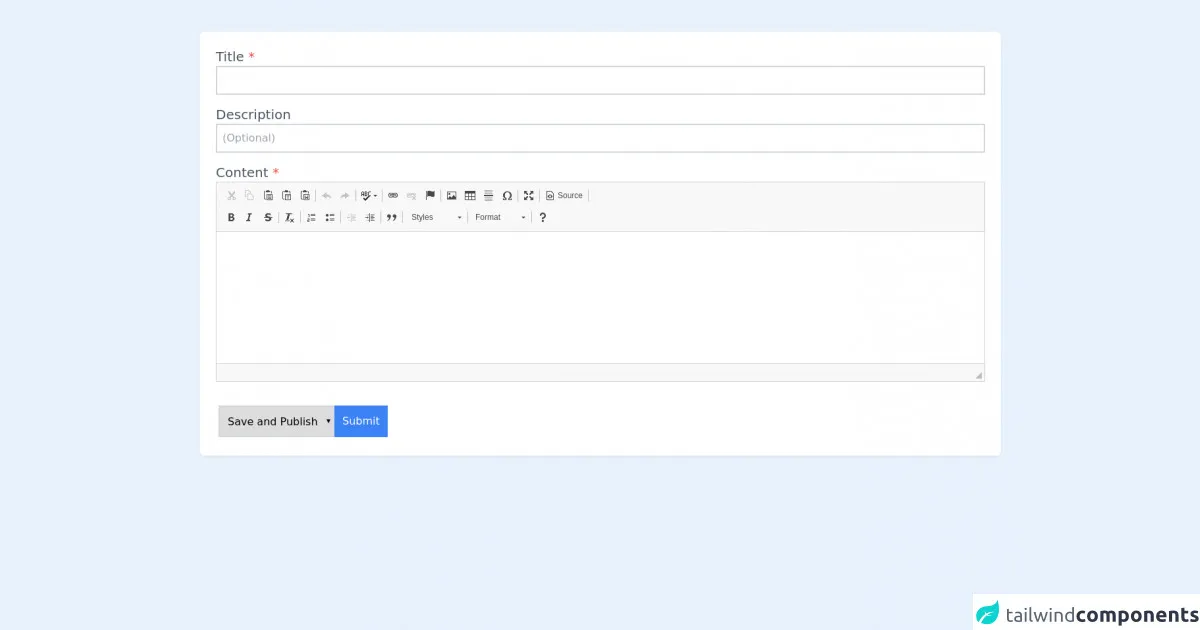- Published on
6 Steps To Make A Simple Blog/Post Form with CKEditor With Tailwind CSS Like A Pro In Under An Hour

- What is Tailwind CSS?
- The description of Simple Blog/Post Form with CKEditor ui component
- Why use Tailwind CSS to create a Simple Blog/Post Form with CKEditor ui component?
- The preview of Simple Blog/Post Form with CKEditor ui component.
- The source code of Simple Blog/Post Form with CKEditor ui component.
- How to create a Simple Blog/Post Form with CKEditor with Tailwind CSS?
- Step 1: Set up your project
- Step 2: Create the HTML structure
- Step 3: Add the Tailwind CSS classes
- Step 4: Initialize the CKEditor instance
- Step 5: Submit the form data
- Step 6: Style the success message
- Conclusion
As a FrontEnd technology blogger, I understand the importance of having a well-designed and functional blog or post form. In this article, I will guide you through the process of creating a simple blog/post form with CKEditor and Tailwind CSS. By following these six simple steps, you can create a professional-looking form in under an hour.
What is Tailwind CSS?
Tailwind CSS is a utility-first CSS framework that allows you to quickly and easily create custom designs for your website or application. It provides a set of pre-defined classes that you can use to style your HTML elements. Tailwind CSS is highly customizable and can be used with any front-end framework or library.
The description of Simple Blog/Post Form with CKEditor ui component
A simple blog/post form with CKEditor is a user interface component that allows users to input text and images into a form that can be submitted to a server. CKEditor is a WYSIWYG editor that provides a rich set of features for formatting text, inserting images, and creating links. By combining CKEditor with Tailwind CSS, you can create a beautiful and functional blog/post form.
Why use Tailwind CSS to create a Simple Blog/Post Form with CKEditor ui component?
Tailwind CSS provides a set of pre-defined classes that can be used to style your HTML elements. This makes it easy to create a custom design for your blog/post form without having to write a lot of CSS code. Additionally, Tailwind CSS is highly customizable, which means you can easily modify the styles to fit your specific needs.
The preview of Simple Blog/Post Form with CKEditor ui component.
Here is a preview of what the simple blog/post form with CKEditor and Tailwind CSS will look like:
Free download of the Simple Blog/Post Form with CKEditor's source code
The source code of Simple Blog/Post Form with CKEditor ui component.
Here is the source code for the simple blog/post form with CKEditor and Tailwind CSS:
<div class="py-12">
<div class="max-w-7xl mx-auto sm:px-6 lg:px-8">
<div class="bg-white overflow-hidden shadow-sm sm:rounded-lg">
<div class="p-6 bg-white border-b border-gray-200">
<form method="POST" action="action.php">
<div class="mb-4">
<label class="text-xl text-gray-600">Title <span class="text-red-500">*</span></label></br>
<input type="text" class="border-2 border-gray-300 p-2 w-full" name="title" id="title" value="" required>
</div>
<div class="mb-4">
<label class="text-xl text-gray-600">Description</label></br>
<input type="text" class="border-2 border-gray-300 p-2 w-full" name="description" id="description" placeholder="(Optional)">
</div>
<div class="mb-8">
<label class="text-xl text-gray-600">Content <span class="text-red-500">*</span></label></br>
<textarea name="content" class="border-2 border-gray-500">
</textarea>
</div>
<div class="flex p-1">
<select class="border-2 border-gray-300 border-r p-2" name="action">
<option>Save and Publish</option>
<option>Save Draft</option>
</select>
<button role="submit" class="p-3 bg-blue-500 text-white hover:bg-blue-400" required>Submit</button>
</div>
</form>
</div>
</div>
</div>
</div>
<script src="https://cdn.ckeditor.com/4.16.0/standard/ckeditor.js"></script>
<script>
CKEDITOR.replace( 'content' );
</script>
How to create a Simple Blog/Post Form with CKEditor with Tailwind CSS?
Now that you understand what Tailwind CSS is and why it's useful for creating a simple blog/post form with CKEditor, let's dive into the six steps to create your own form.
Step 1: Set up your project
The first step is to set up your project. You can do this by creating a new HTML file and linking to the necessary CSS and JavaScript files. You will need to include the CKEditor and Tailwind CSS libraries in your project.
Step 2: Create the HTML structure
The next step is to create the HTML structure for your form. You will need to create a form element and add input fields for the title and body of the blog/post. You will also need to add a div element for the CKEditor instance.
Step 3: Add the Tailwind CSS classes
Once you have created the HTML structure, you can start adding the Tailwind CSS classes to style your form. You can use the pre-defined classes to style your input fields, buttons, and other elements.
Step 4: Initialize the CKEditor instance
The next step is to initialize the CKEditor instance. You can do this by creating a new instance of the CKEditor class and passing in the ID of the div element that you created in Step 2.
Step 5: Submit the form data
Once the user has entered the title and body of the blog/post and added any images or links, they can submit the form data. You will need to add an event listener to the form submit button and send the data to the server using AJAX.
Step 6: Style the success message
Finally, you can style the success message that is displayed when the form data is successfully submitted. You can use the pre-defined Tailwind CSS classes to style the message and add any additional custom styles.
Conclusion
In conclusion, creating a simple blog/post form with CKEditor and Tailwind CSS is a straightforward process that can be completed in under an hour. By following these six steps, you can create a professional-looking form that is both functional and aesthetically pleasing. With the help of Tailwind CSS, you can easily customize the design to fit your specific needs.